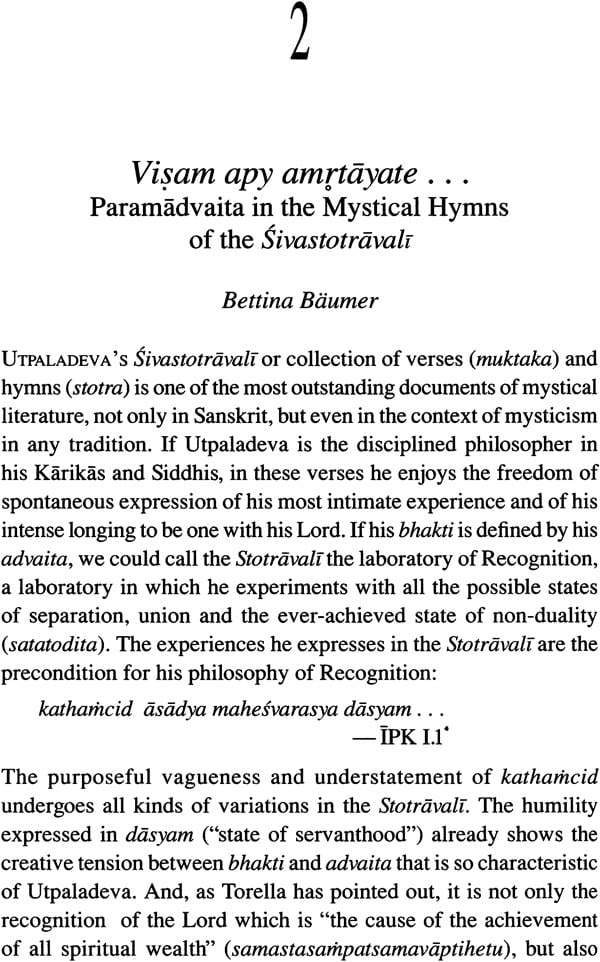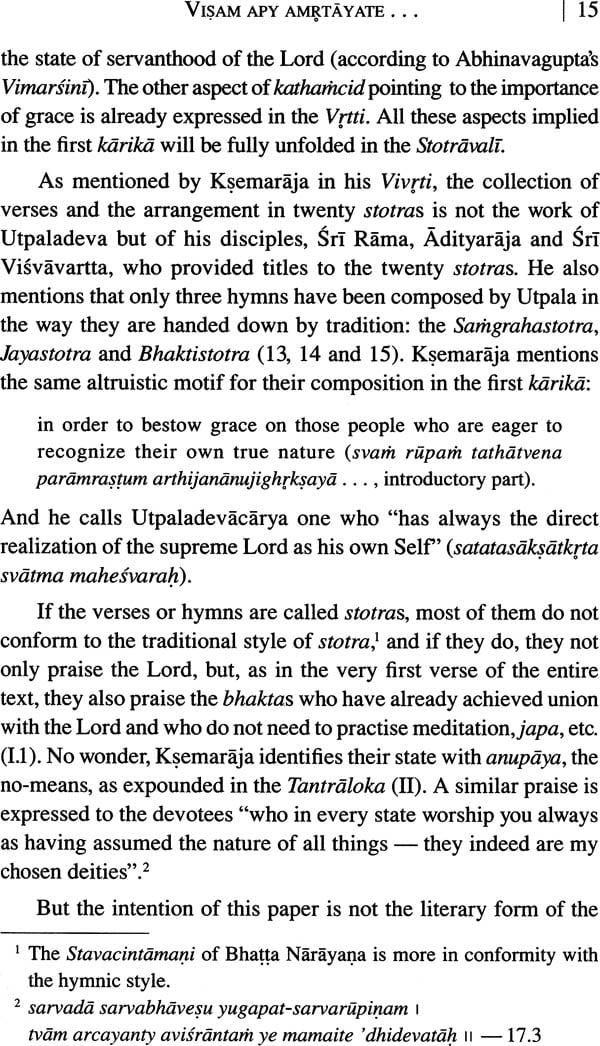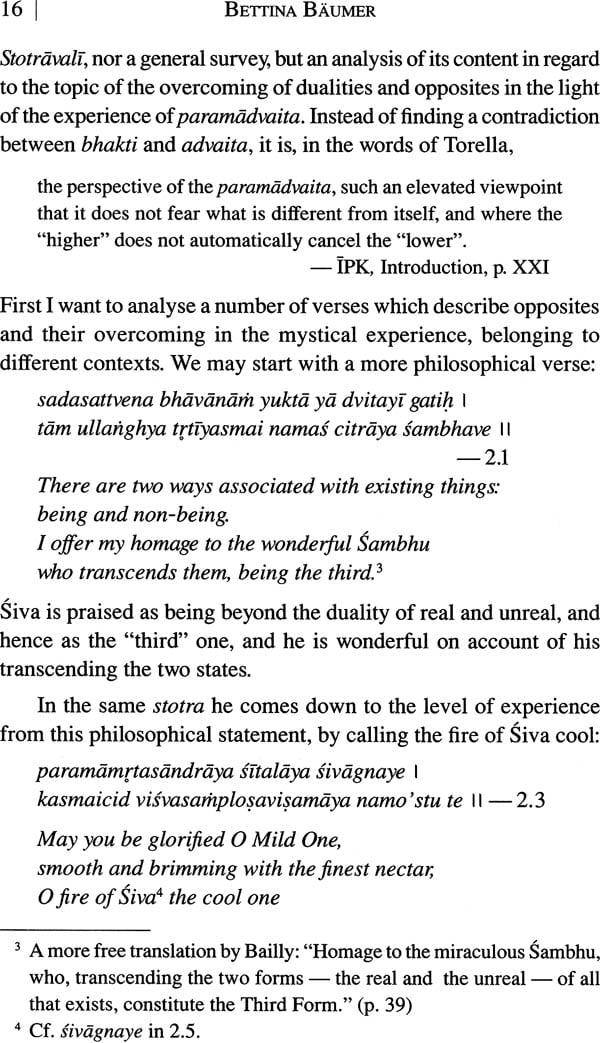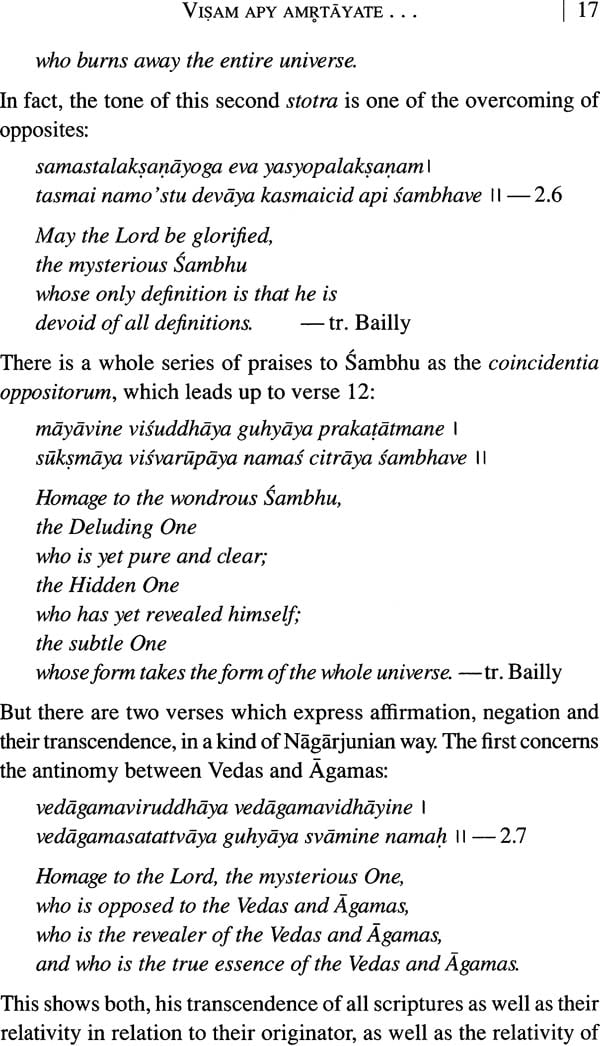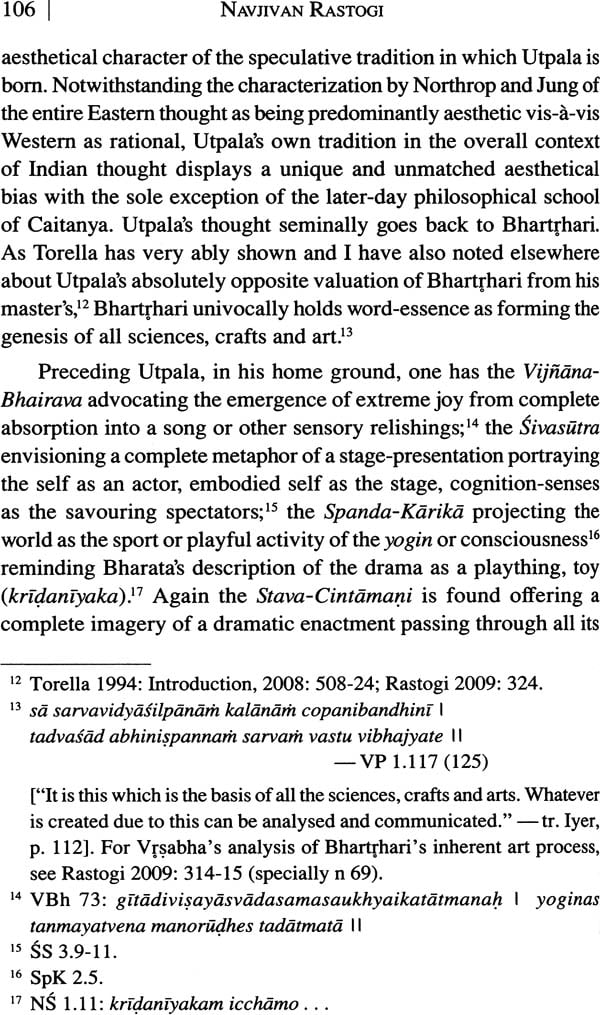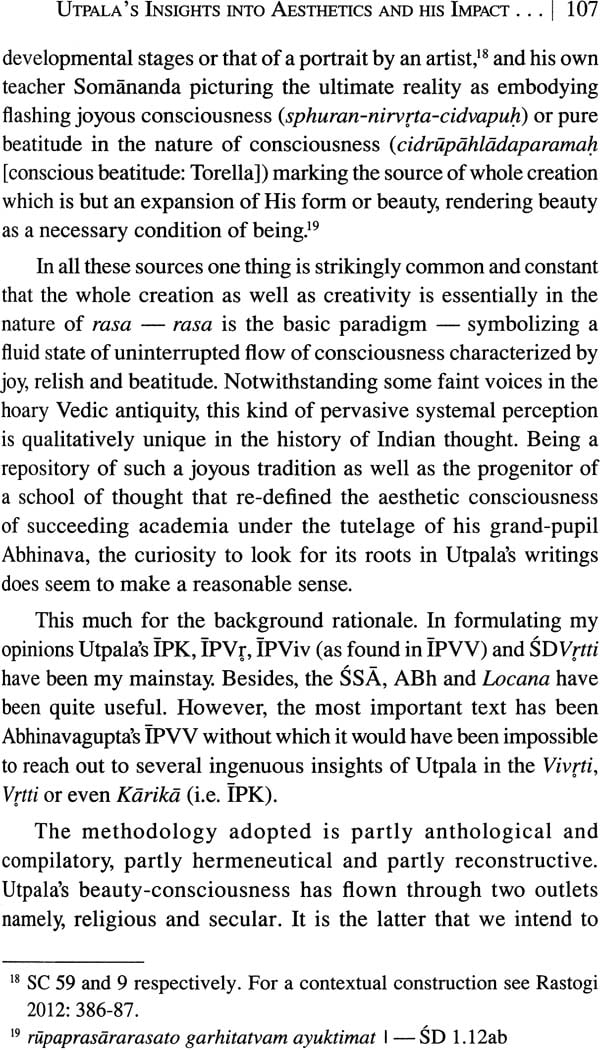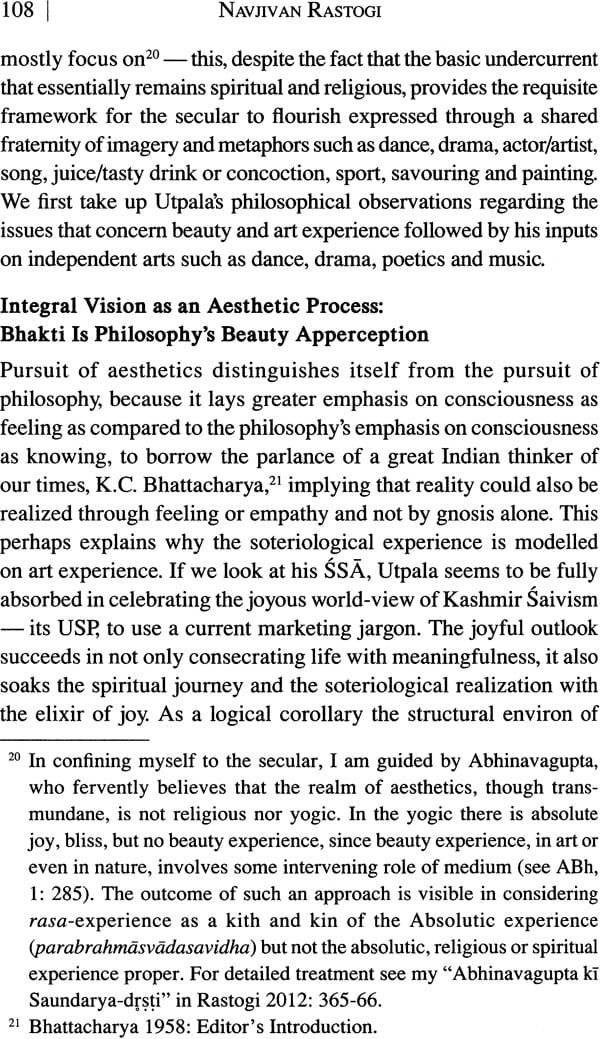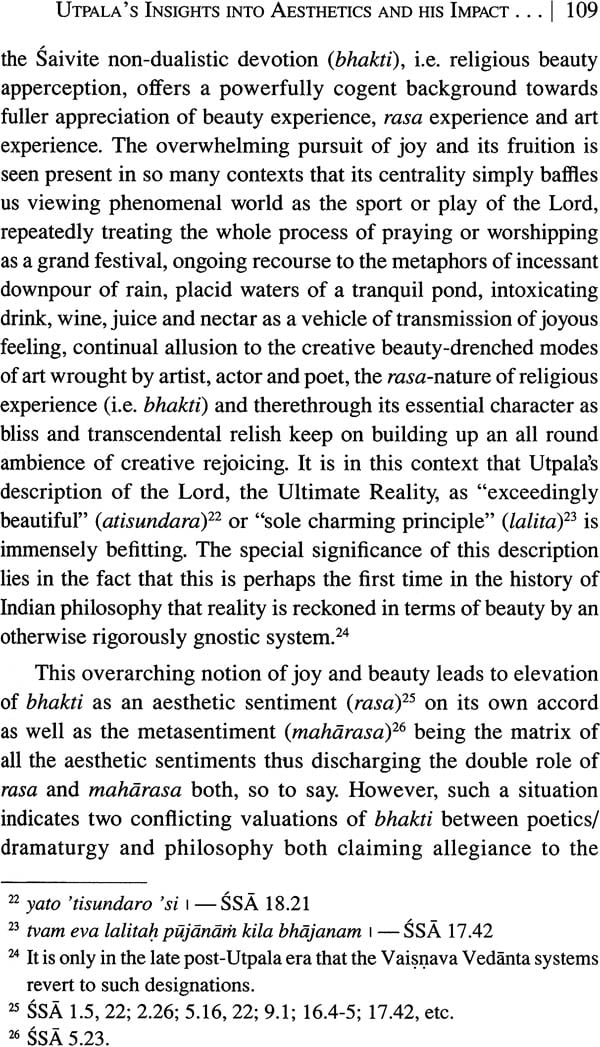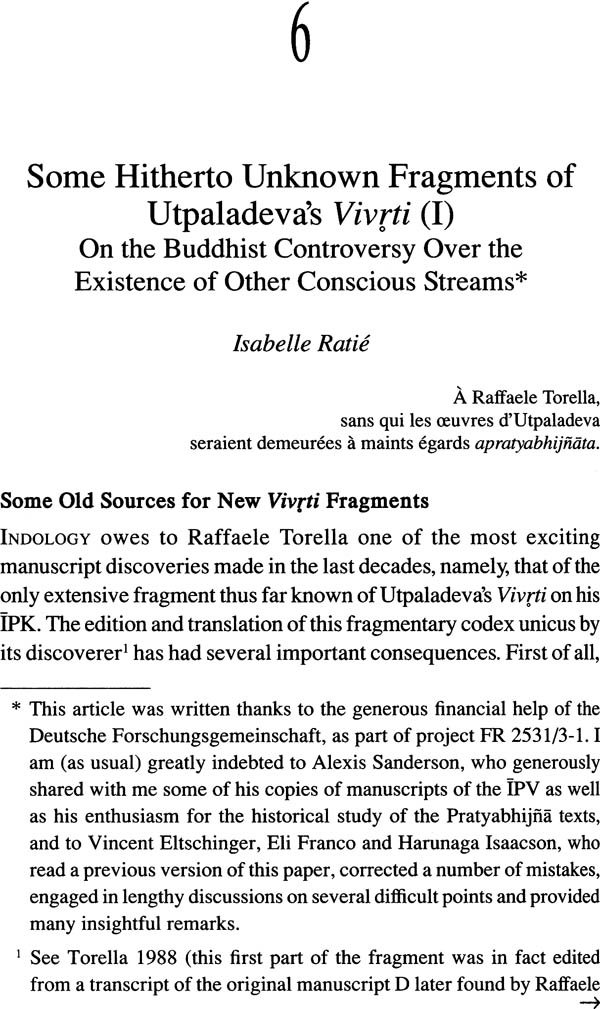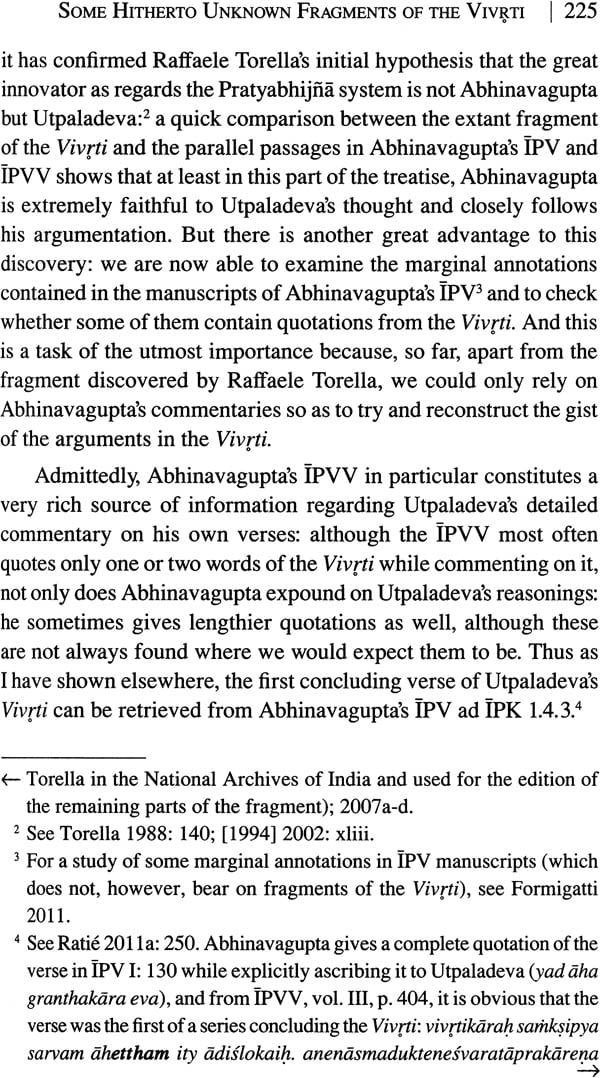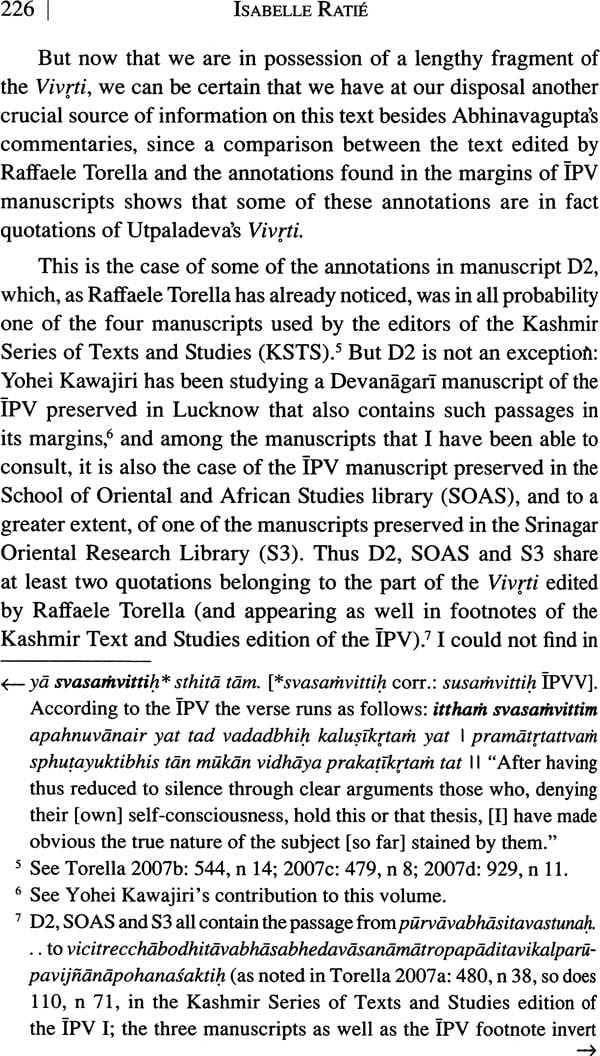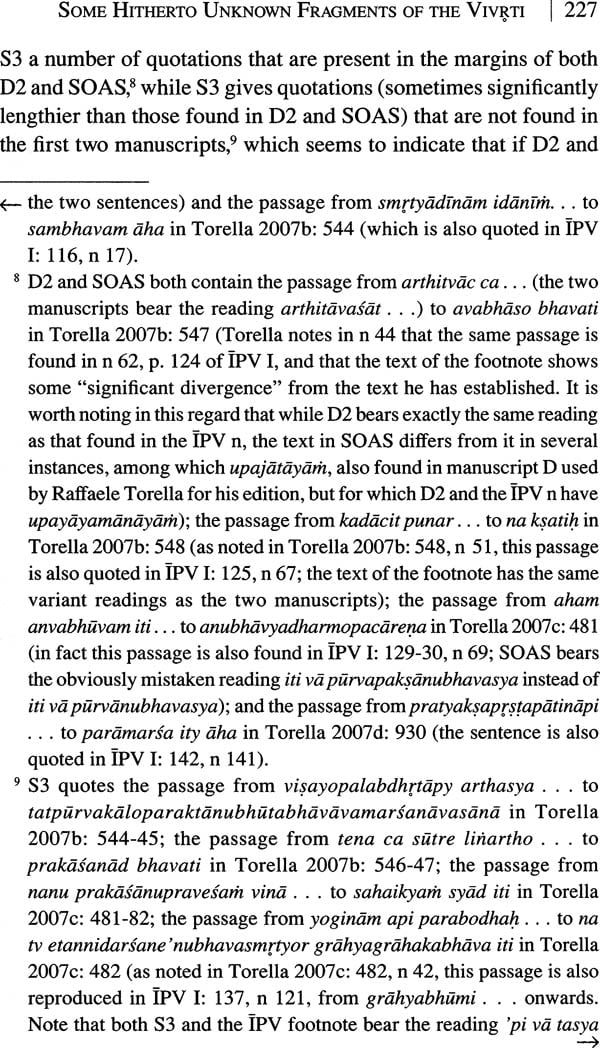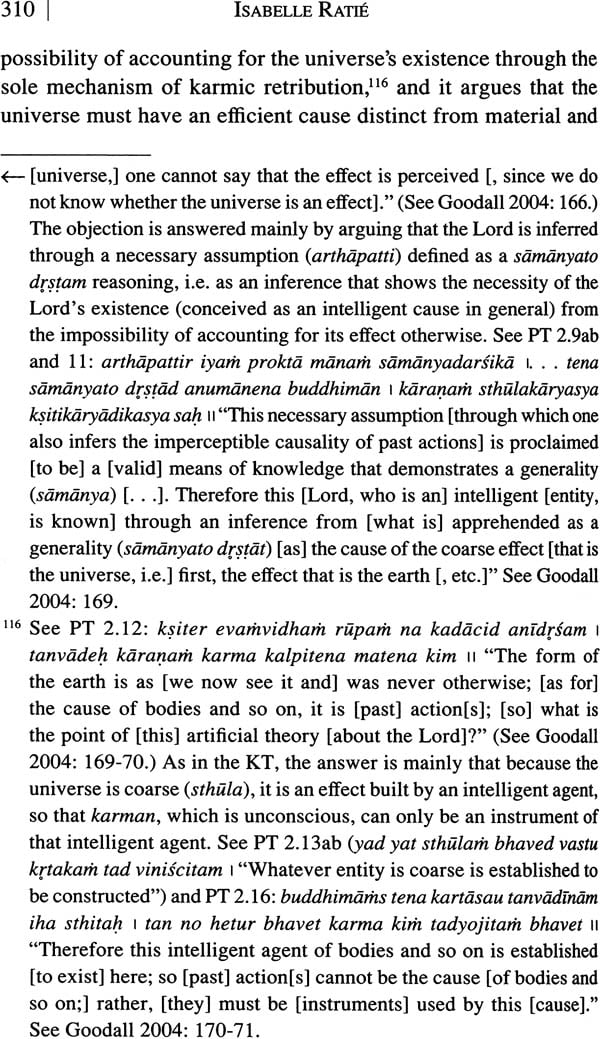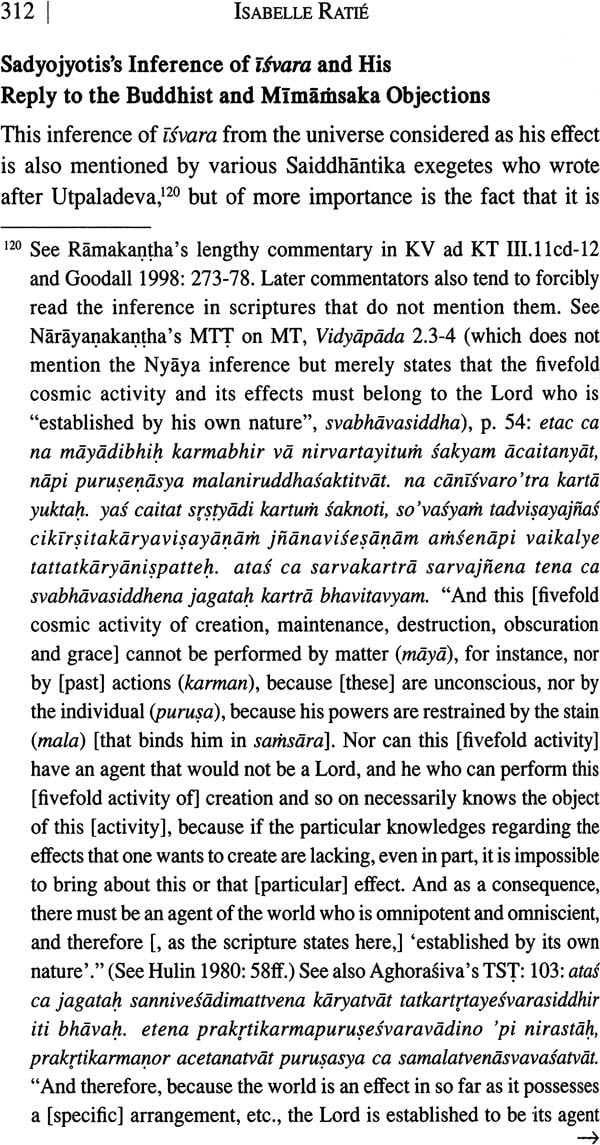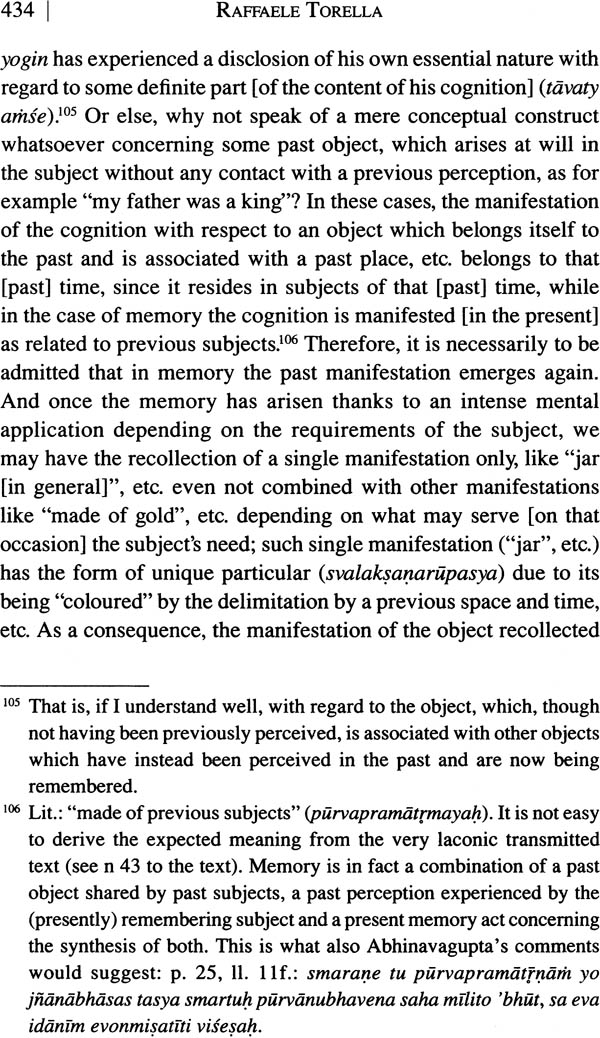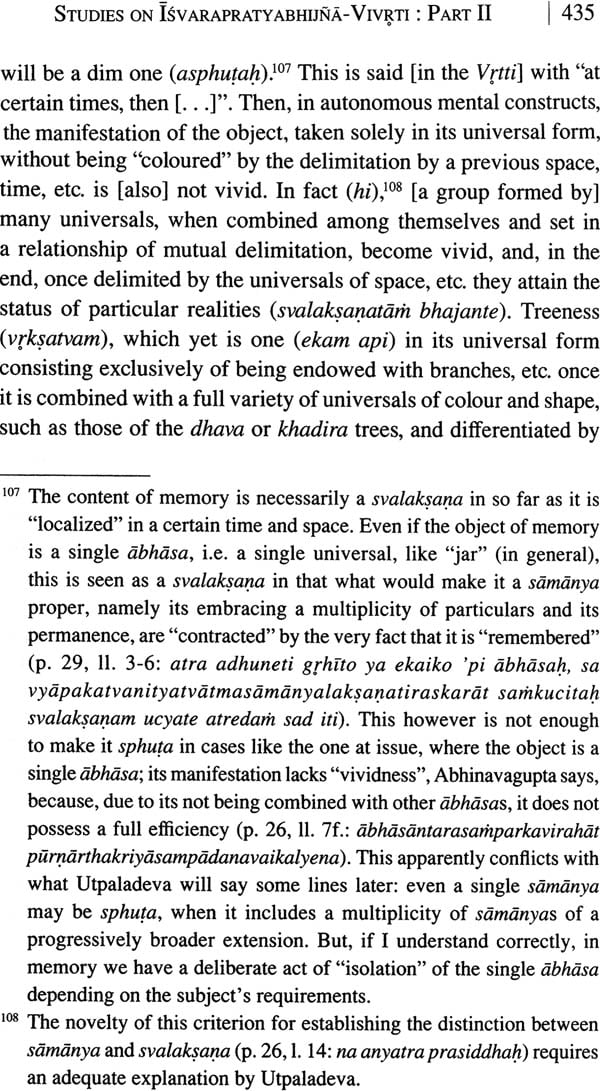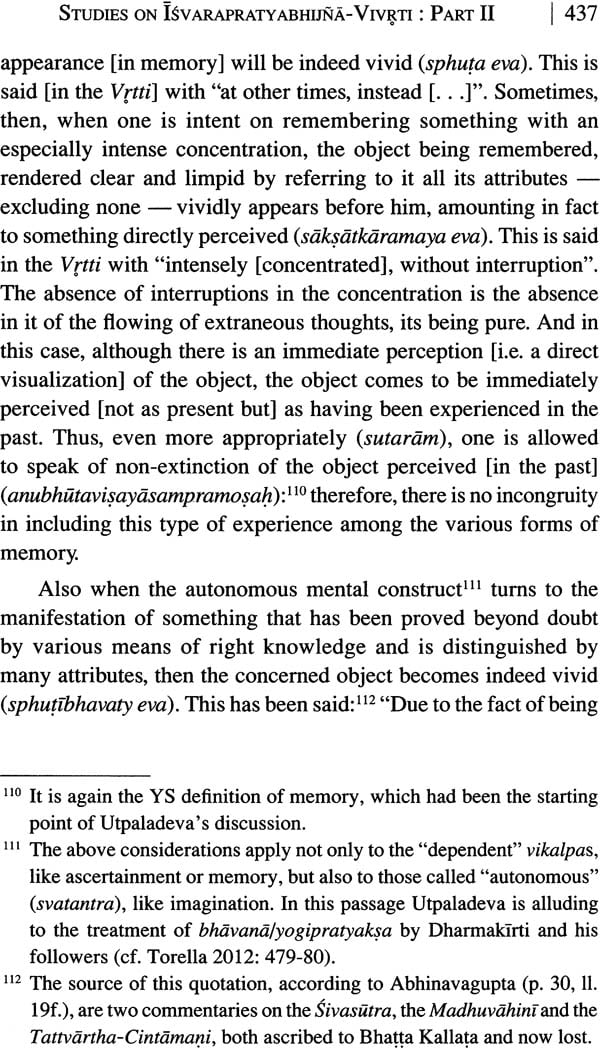
Utpaladeva (Philosopher of Recognition)
Book Specification
| Item Code: | NAL937 |
| Author: | Raffaele Torella and Bettina Baumer |
| Publisher: | D. K. Printworld Pvt. Ltd. |
| Language: | English |
| Edition: | 2016 |
| ISBN: | 9788124608432 |
| Pages: | 460 |
| Cover: | Hardcover |
| Other Details | 8.5 inch X 5.5 inch |
| Weight | 770 gm |
Book Description
The book, which partly derives from the papers offered at the first International Seminar on Utpaladeva (IIAS, Shimla 2013), is the first ever attempt at presenting a comprehensive portrait of one of the most important philosophers of pre-modern India, so far mainly taken into account as amere predecessor of the great Abhinavagupta. Recent studies by R. Torella and others have shown the central importance of Utpaladeva in the elaboration of the Pratyabhijna philosophy, and reduced the role of Abhinavagupta to that of that of this brilliant commentator.
The contributors to the present volume have shown the multifarious aspects of Utpaladeva, not only an outstanding metaphysicion and epistemologist, engaged in a strenuous critical dialogue about all with the Buddhist logicians, but also one of the most extraordinary mystical poets of India. For the first time his contribution to poetics and aesthetics has been duly highlighted.
The book contains two appendices with the critical edition and translation by R. Torella of fragments from Uipaladeva;s long commentary (Vivrti) on his Isvarapratya-bhijna-karika and Vrtti, one of the most important works of Indian philosophy as a whole, so far deemed to be totally last.
This book should generate great interest among scholars of Sanskrit and philosophy for its uniqueness and should serve the curiosity of each and every acholarly reader of Kashmir Saivism.
Raffaela Torella is Professor of Sanskrit at University of Rome “Sapieza”, philosophy and Religiopn, and Indology.
Main publications: The Isvarapratyabhijna-karika of Utpaladeva’s with the Author’s Vritti. Critical Edition and Annotated Translation, Delhi: Motilal Banarsidass with Ksemaraja’s Vimarsini (Milan: Adeiphi, 2013; in Italian); The Philosopfical Traditions of India; An Appraisal, Varansi: Indica Books, 2011; (with G. Boccali) Eros and Emotions in India and Tibet (Turin; Einaudi, 2007; in Italian).
Dr. Bettina Baumer, Indologist from Austria and Professor of Religious Studies (Visiting Professor at several universities), living and working in Varanasi since 1967, is the author and editor of a number of books and over 50 research articles. Her main fields of research are non-dualistic Kashmir Saivism, Indian aesthetics, temple architecture and religious traditions of Odisha, and comparative mysticism. She has been Coordinator of the Indira Gandhi National Centre for the Arts, Varanasi, and Fellow, Indian Institute of Advanced Study, Shimla. She has translated important Sanskrit texts into German and English.
Utpaladeva or Utpalacaya (c. 925-975) is one of the greatest philosophers that India has produced, but he is haridly known in India itself. After Somananda (c.900-950) who laid the foundation for the philosophy of Recognition (Pratyabhijna Darsana) with his Sivadrsti, Utpaladeva established this school by his philosophical works: Isvarapratyabhijna-karika and Vrtti, composed at the same time, and, subsequently, in turn commented upon in a long and complex Vivrti, which has come down to us only in fragments; the Siddhitrayi, three terse terse treatises on specific subjects (Ajadapramatrsiddhi “Proof of the sentient knower”, Sambandhasiddhi “Proof of relation”; Isvarasiddhi “Proof of the Lord”); and a Vrtti on the Sivadrsti. Besides authoring philosophical works, Uipaladeva was also a mystical poet, as expressed in his splendid hymn collection, Sivastotravali. The Pratyabhijna philosophy was continued by Utpaladeva’s disciple Laksmanagupta (of whom nothing has come down to us) and by Laksmanagupta’s disciple, the great Abhinavagupta (c.975-1025) who composed two extensive commentaries on thePratyabhijna, and took it as the theoretical basis for his Trika synthesis in the Tantraloka.
On 20-21 August 2010, an internal seminar was held at the Indian Institute of Advanced Study (IIAS), Shimla, on “Utpaladeva, Philosopher of Recognition”, organized by Raffaele Torella and Bettina Baumer, with the participation of scholars from India and Europe. The participants were R. Torella (Rome), B. Baumer (Varanasi-Salzburg), K.D. Tripathi (Varanasi), G.C. Tripathi (Delhi), D. Cuneo (Cambridge), M.H. Zaffar (Srinagar) and A. Wenta (Shimla-Oxford). At the very last moment, other prospective participants – N. Rastogi (Lucknow), R. Tripathi (Delhi), I. Ratie (Paris) and Y. Kawajiri (Kyoto) – couldn’t come, but have sent in their papers.
Two articles by Raffaele Torella, previously published n two Felicitation Volumes not easily available in India, have been added as Appendices. They contain studies on Utpaladeva’s Vivrti, showing the central role of Utpaladeva in the elaboration of the Pratyabhijna philosophy: as we can see from the extant parts of the Vivrti, in most cases Abhinavagupta will simply follow and develop the lines of Utpala’s complex arguments.
It is high time the genius of Utpaladeva is rediscovered, and he is given the due place in the history of Indian thought as well as in the intellectual and spiritual dimensions of our time.
Thr Pratyabhijna provides non-dual Saivism of Kashmir with a “philosophy”. A presentation of the Pratyabhijna doctrines involves, first and foremost, giving voice to one of the most original and peculiar components of India’s philosophical and religious scenario from medieval times down to our own: what is known in the West as “Tantrism”. It will be necessary to stretch a discreet veil over the incautious remarks of a well-known scholar like Georg Feuerstein:
Tantrism’s contribution to philosophy is negligible. Its unicity lies wholly within the practical sphere, the sadhana. From a philosophical point of view, there is no hiatus between Tantrism and previous traditions. Buddhist Tantrism rests substantially on the foundations of the Madhyamika school of Mahayana, and its Hindu counterpart on those of the cognate Advaita-Vedanta.
In actual fact, Pratyabhijna, which provides the theoretical basis for all Hindu Tantrism, constitutes one of the highest and most original moments of Indian thought (it has, moreover, very little to do with Vedanta). The principal aim of the Pratyabhijna philosophers was to allow the Tantric Saiva sects to emerge from the dimension of restricted circle, often devoted to transgressive practices, and establish themselves in the stratum of social normality, by internalizing, or in any case circumscribing, their own apecific differences. Their main addressees were no more the ascetics, but, typically, the householders. As a consequence, the Pratyabhijna engages in a far-reaching dialogue with Indian philosophy of its time, accepting its modalities and rules. The initial nucleus comprises non-dualistic Saivite scriptures, the Bhairava Tantras – Bhairava being the terrible from of the God Siva, in whom cruelty and violence are metaphors for rampant energy, far distant from the unmoving and bloodless deities of Vedanta. Bhairava coincides with the “I” of every creature. In first sddressing the notion of “I”, so much disliked by Brahmanic thought, non-dualist Saivism and in primis Utpaladeva implicitly state the centrality of free movement as against the always lurking reification connected to the notion of atman, the I as substance. As compared to the I – the Supreme Consciousness – the flow of the phenomenal world is not a (bad) dream from which one must awake as soon as possible, but the spontaneous manifestation of the Absolute itself. The concept of maya, central to Vedanta, is not eliminated: maya is taken to be the power of the Lord, even his highest power, otherwise known as svatantryasakti (power of freedom), and svatantryavada (doctrine of freedom) becomes one of the favourite names for this school.
Utpaladeva inaugurates what was to become a salient feature of the whole Trika in Abhinavagupta’s synthesis: namely, the tendency not to constitute a monolithic doctrine and a world of religious experience to oppose en bloc everything that does not coincide with it (as in the ekantin “absolutistic” trends) but to distinguish planes, which are hierarchically ordered but in which the “higher” does not automatically cancel the “lower” (as Somananda had already said, Siva is everywhere, even in differentiation, pain and hell). This is the perspective of the Paramadvaita “Supreme Non-Duality”, such an elevated viewpoint that it does not what is different from itself, is not forced to make a choice.
While Somananda is considered the founder of the Pratyabhijna, its full-fledged elaboration is due to Utpaladeva and Abhinavagupta. Somananda’s Sivadrsti is to be considered the first philosophical work of Kashmieian Saiva Advaita, its only predecessor being the Spanda-Karika, in which however the experiential and scriptural approach largely prevails over philosophical elaboration. The Sivadrsti is unanimously recognized as the first work of the Pratyabhijna school, despite the fact that the work pratyabhijna does not even occur in it (at least in its pregnant meaning). Anhinavagupta at the beginning of his Vimarsini on the Isvarapratyabhijna-Karika does not hesitate to say that Utpaladeva’s masterwork is in fact only a “reflected image” of the Sivadrsti. This is, of course, not to be taken literally, for, although the Sivadrsti was a powerful source of inspiration for Utpaladeva, it is only with the Isvarapratyabhijna-Karika that the Pratyabhijna becomes a very original and elaborate philosophical system. In the Somanandea-Utpaladeva-(Laksmanagupta)-Abhinavagupta triad it was the latter who largely overshadowed his predessors. Among the Pratyabhijna texts, Abhinavagupta’s Isvarapratyabhijna-Vimarini became by far the most “popular” – if I may use this abjective for one of the profoundest and most sophisticated worldviews that India has ever profoundest and most sophisticated that India has ever produced. The main victim of the success of the Vimarsini was the extraordinarily important Vivrti or Tika by Utpaladeva, of which only fragments have survived.
| Preface | V | |
| 1 | Imortance of Utpaladeva: An Introduction | 1 |
| 2 | Visam apy amrtayate… Paramadvaita in the Mystical Hymns of the Sivastotravali | 14 |
| 3 | Detonating or Defusing Desire: From Utpaladeva's Ecstatic Aesthetics to Abhinavagupta's Art Theory | 31 |
| 4 | New Fragments of the Isvarapratyabhijna-vivrti | 77 |
| 5 | Utpala's Insights into Aesthetics and His Impact on Abhinavagupta's Aesthetic Speculation | 102 |
| 6 | Some Hitherto Unkown Fragments of Utpaladeva's Vivrti (I): On the Buddhist Controversy Over the Existence of Other Conscious Streams | 224 |
| 7 | Utpaladeva's Proof of God: On the Purpse of the Isvarasiddhi | 257 |
| 8 | Alamkaras in the Stotras of Utpaladeva | 341 |
| 9 | The Twelve Kalis and Utpaladeva's Appraisal of the Sensory Experience | 352 |
| Appendices | ||
| I | Studies on Utpalaadeva's Isvarapratyabhijna-Vivrti | 370 |
| Part: I Anupalabdhiand Apoha in a SAIVA Garb | ||
| II | Studies on Utpaladeva's Isvarapratyabhijna-Vivrti | 404 |
| Part II: What is Memory | ||
| Contributors | 441 | |
| Index | 444 |
